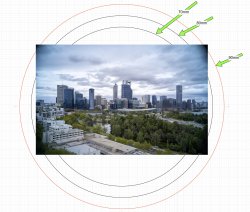Here is an example of the Rodenstock (Sinar) Digaron-S HR 60mm/F4, shot with 3 rows and 3 columns on a Cambo Actus G, stitched together. So 20mm shift left and right, 15mm rear fall and 12mm rear rise on a 36mm wide x 24mm tall sensor, making the coverage 76mm wide by 51mm tall.
I have tried my best to place the stitched image against image circles of 70mm, 80mm and 90mm to give an indication of the circle of illumination and the location of the hard stop, if that is the correct term for it.
The first image shows the light falloff uncorrected.
The second image shows 100% vignette correction in Lightroom, to better show where the hard stop is.
My conclusions are that light falloff begins gently after 70mm, and significantly after 80mm, and that the hard stop is at around 90mm.

I have tried my best to place the stitched image against image circles of 70mm, 80mm and 90mm to give an indication of the circle of illumination and the location of the hard stop, if that is the correct term for it.
The first image shows the light falloff uncorrected.
The second image shows 100% vignette correction in Lightroom, to better show where the hard stop is.
My conclusions are that light falloff begins gently after 70mm, and significantly after 80mm, and that the hard stop is at around 90mm.


